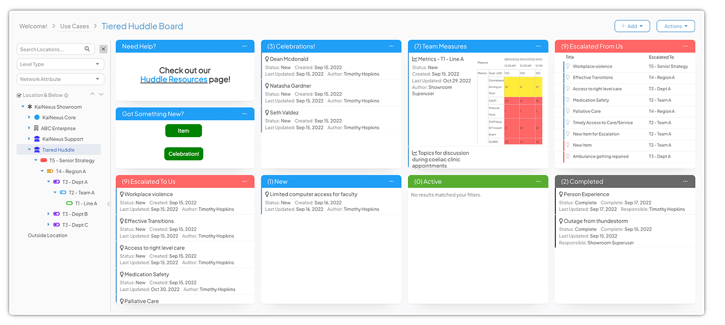 Effective leadership in healthcare organizations requires open lines of communication between caregivers working directly with patients and hospital administrators who seek to protect the interests of all stakeholders. In addition, operationally excellent healthcare organizations engage in nimble, data-driven decision-making and foster a culture of respect and value.
Effective leadership in healthcare organizations requires open lines of communication between caregivers working directly with patients and hospital administrators who seek to protect the interests of all stakeholders. In addition, operationally excellent healthcare organizations engage in nimble, data-driven decision-making and foster a culture of respect and value.
Providing the best possible care requires that problems are identified and addressed promptly. Many healthcare organizations have discovered that this is best achieved by engaging clinical and non-clinical staff across the organization in robust collaboration and cross-discipline communication. The tiered huddle approach provides a structure for this coordination and supports increased accountability.
What Sets Tiered Huddles Apart
The idea of huddle meetings comes from other industries like automotive manufacturing, aviation, nuclear energy, and emergency services. In the United States, huddles have become increasingly common in several diverse healthcare settings to improve patient and staff safety. Huddles are short interdisciplinary meetings lasting about 10 minutes that occur in a designated work area (e.g., inpatient units, laboratory, environmental services, emergency, radiology, etc.) The goal of huddles is to improve cross-discipline communication, review daily activities, share emerging information, coordinate services, discuss workflow concerns, and address patient safety preventative actions.
Tiered huddles are more focused on cross-discipline communication. They include everyone from frontline staff to senior leadership. The goal is proactively identifying and addressing systemic concerns such as safety, staffing, resource allocation, and operational issues.
Example Tiered Huddle Structure
The number of tiers depends on the size of the organization and the scope of care provided. The tiered approach ensures that the most critical unresolved issues are quickly flagged for leadership so that they get due attention. Tiered huddles are effective at streamlining the flow of information, improving collaboration, achieving care coordination, improving safety, and ensuring optimal patient outcomes.
Tier Participants
Tiers 1-4 focus on the clinical setting:
- Tier 1: Caregivers at the unit level and managers/supervisors
- Tier 2: Managers and directors
- Tier 3: Nursing directors and ACNO/CNO and Operations President, COO
- Tier 4: President, COO, ACNO/CNO
Tiers 5 and 6 focus on the enterprise:
- Tier 5: Hospital system presidents, COOs, CNOs, and ECNO
- Tier 6: CEO and Operations Council
Generally, each tier huddles for no more than 15 minutes, and then a subset of each level uses the same amount of time to prepare for and join the next huddle tier. This approach ensures that information moves consecutively and vertically from the frontline staff to the executive leadership teams. Tiered huddle information is displayed using a visual management system.
According to the Institute for Healthcare Improvement, Team Huddles should:
- Occur at the start of each shift.
- Include a formal review of key metrics, problems, and action items.
- Allow team members to discuss incoming patients.
- Anticipate the needs or concerns of patients and team members.
There are several important considerations when structuring a tiered huddle meeting:
- Define the meeting rules: Establish a standard for each huddle and set out ground rules for participation so that everyone knows their ideas and suggestions matter.
- Establish etiquette: Be clear about when team members should share their concerns and offer opportunities for improvement.
- Have a conflict resolution plan: When disagreements inevitably happen, know in advance how and by whom they will be resolved.
- Use huddles as an improvement opportunity: Avoid the temptation to turn the huddle into an activity report. Instead, focus on actionable areas for improvement.
The Benefits of Tiered Huddles
Tiered huddles allow essential information to flow through an organization quickly. They remove the barriers that prevent top leadership from understanding the issues facing frontline staff and potentially impacting patient care. The structure of tiered huddles makes it possible to:
- Understand and react to emerging trends
- Ensure accountability up and down the tiers
- Clairfiy for staff who is responsible for addressing each problem
- Resolve issues quickly
- Delegate problem-solving responsibility
Digital Huddle Boards
Huddle boards visualize and guide discussions on the current status and trends in the work area where the tiered huddle occurs. The huddle board is designed to quickly identify problems that can be addressed by frontline staff and those that need to be elevated to the next level of leadership so that they can be addressed rapidly.
Huddle boards allow participants to quickly understand the progress of process improvements, ranging from patient safety concerns to complex improvement projects. While there are countless ways to structure a huddle board, in healthcare, most contain critical metrics and targets for improvement. The number of falls might be tracked in a hospital, for example.
Whatever layout an organization chooses, the content should be meaningful and actionable for those attending the huddle and those in the adjacent huddle tiers.
While physical huddle boards on the wall may work well for team huddles, they are less effective in tiered huddle organizations. Because information moves up and down the tiers and from workplace to workplace, digital huddle boards are a much better option.
Information from all huddle meetings is collected in one unified platform and then presented selectively to the appropriate tier during the huddle meeting. This approach ensures that all relevant data is captured and the results of the huddle meetings can be measured over time.
One critical advantage of digital huddle boards over physical ones is that they capture and store information from huddle meetings for as long as it is useful. As a result, teams are unrestricted by space, and there is no need to permanently remove one concern to make room for the next. They also offer transparency that does not require team members to physically go from one workspace or even be at the facility at all.

Executive Commitment and Staff Education
Before planning and implementing a tiered huddle structure, it is essential to create consensus supporting the initiative. Executives must communicate the purpose of tiered huddles and the expected benefits and related process outcomes. They should share the structure and tools that will be used to support huddles and iterate on the importance of the time limits and cadence of huddle meetings. As with any improvement initiative, success depends on top leadership's engagement and support.
In order for organizational change to succeed, information about the planning and implementation of the approach needs to be shared as widely as possible. Staff should feel educated, invested, and well-prepared to participate. Organizations with a rigid top-down approach to management must take special care to help team members embrace this new, two-way approach to daily improvement. A culture of ownership and accountability is essential for achieving operational excellence.
Tiered huddles are increasingly popular in healthcare because healthcare organizations are complex and deal with life-and-death matters. Minor problems can become critical in no time at all. The tiered huddle approach ensures the unimpeded flow of crucial information and improves decision-making at every level. They are an outstanding option for improving outcomes for patients, staff, and leaders alike.



Add a Comment